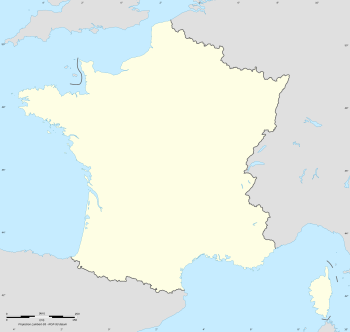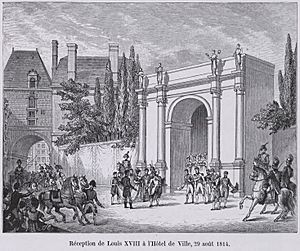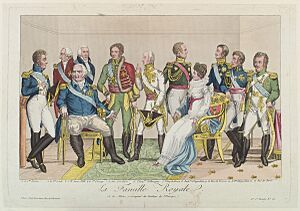First Restoration facts for kids
Quick facts for kids
Kingdom of France
Royaume de France
|
|||||||||
|---|---|---|---|---|---|---|---|---|---|
| 1814–1815 | |||||||||
|
|
|||||||||
|
Motto: Montjoie Saint Denis!
"Montjoy Saint Denis!" |
|||||||||

The Kingdom of France in 1814
|
|||||||||
| Capital | Paris | ||||||||
| Common languages | French | ||||||||
| Religion | Roman Catholicism | ||||||||
| Government | Constitutional monarchy | ||||||||
| King | |||||||||
|
• 1814–1815
|
Louis XVIII | ||||||||
| Prime Minister | |||||||||
|
• 1814–1815
|
Charles de Bénévent (first) | ||||||||
| Legislature | Parliament | ||||||||
| Chamber of Peers | |||||||||
| Chamber of Deputies | |||||||||
| History | |||||||||
| 6 April 1814 | |||||||||
| 30 May 1814 | |||||||||
| 4 June 1814 | |||||||||
| 20 Mar – 7 Jul 1815 | |||||||||
|
• Disestablished
|
20 March 1815 | ||||||||
| Currency | French franc | ||||||||
| ISO 3166 code | FR | ||||||||
|
|||||||||
The First Restoration was a short but important time in French history. It marked the return of the House of Bourbon royal family to the throne of France. This period began in the spring of 1814 after Napoleon gave up his power. It ended in March 1815 when Napoleon made a surprising return during what is known as the Hundred Days.
This new government was formed after a group of powerful countries, called the Sixth Coalition, defeated France. These countries included the United Kingdom, Russia, Prussia, Sweden, and Austria. They had different ideas about who should rule France. After much discussion, Louis XVIII, the brother of the previous king Louis XVI, was chosen. He returned to Paris in April 1814 and moved into the Tuileries Palace.
Contents
What Was the First Restoration?
The First Restoration was a time when France tried to find a balance. It aimed to bring back the monarchy while keeping some of the important changes from the French Revolution. To do this, King Louis XVIII gave the French people a special document called the Charter of 1814. This Charter restored the king's power but also protected some individual rights gained during the Revolution.
Challenges for the New Government
The new government tried to unite the country. However, this approach didn't please everyone. Some very strong supporters of the monarchy, called monarchists, wanted revenge for what they had suffered during the Revolution. Also, the return of the Catholic Church to power and the reduction in the size of the army quickly made enemies for the new king.
Napoleon's Return and the End of the Restoration
In this difficult situation, Napoleon landed back in France on March 1, 1815. He started with a small army but quickly gained support from people who were unhappy with the new king. Napoleon marched across the country, gathering more followers.
King Louis XVIII fled Paris on March 19. The First Restoration government officially ended the next day when Napoleon arrived at the Tuileries Palace. Louis XVIII went to live in Ghent, a city in Belgium. He only returned to the throne after Napoleon's final defeat at the Battle of Waterloo. This second return was called the Second Restoration.
How Louis XVIII Came Back to Power
Louis XVIII became king in 1814 largely thanks to Talleyrand. Talleyrand was Napoleon's former foreign minister. He convinced the winning Allied Powers that bringing back the Bourbon family was the best idea for France.
Allied Powers' Decisions
The Allied Powers initially disagreed on who should be the new king.
- Britain wanted the Bourbons back.
- Austria thought about letting Napoleon's son, Napoleon François Bonaparte, rule.
- Russia was open to either the duc d'Orléans, Louis Philippe, or Jean-Baptiste Bernadotte. Bernadotte was a former French general who was about to become the King of Sweden.
Napoleon himself was offered to keep his throne in February 1814. But this offer came with a condition: France had to return to its 1792 borders. Napoleon refused this offer.
Public Support for the Bourbons
At first, it was unclear if the Bourbon family could really return to power. However, the French people were tired of war and wanted peace. There were also demonstrations supporting the Bourbons in cities like Paris, Bordeaux, Marseille, and Lyon. This public support helped convince the Allies that the Restoration was a good idea.
The Charter of 1814
When Louis XVIII returned, he agreed to a written constitution called the Charter of 1814. This Charter was a key part of the Restoration. It created a government with two parts, or a bicameral legislature.
Government Structure
The two parts of the legislature were:
- The Chamber of Peers: Members inherited their positions or were appointed by the King.
- The Chamber of Deputies: Members were elected.
The role of these chambers was mostly to give advice, except when it came to taxes. Only the King had the power to suggest or approve laws. He also chose or removed government ministers.
Voting Rights and Laws
Voting rights were very limited. Only men who owned a lot of property could vote. This meant that only about 1% of the population could participate in elections.
Many of the changes from the French Revolution were kept.
- The Napoleonic Code remained. This code guaranteed some legal equality and civil liberties for men.
- Peasants were allowed to keep the lands they had bought during the Revolution (called biens nationaux).
- The new system of dividing the country into départments was also kept.
- The relationship between the church and the state continued to be managed by the Concordat of 1801.
Even though the Charter was a condition for the King's return, Louis XVIII stated that he was "granting" it. He said it was given "by the free exercise of our royal authority." This showed he believed his power came from God, not from the people.
Losing Public Support
After an initial period of popularity, Louis XVIII quickly started to lose support. This happened because of his actions that seemed to reverse the changes of the French Revolution.
Symbolic Changes
Some changes were symbolic but very important to people:
- The tricolore flag, a symbol of the Revolution, was replaced with the white flag of the old monarchy.
- Louis was called "Louis XVIII," suggesting he was the successor to Louis XVII, who never actually ruled. He was also called "King of France" instead of "King of the French," which sounded like he owned the country.
- The monarchy also recognized the anniversaries of the deaths of Louis XVI and Marie Antoinette. These were the king and queen who were executed during the Revolution.
Real Problems for People
Other issues caused more direct problems:
- The Catholic Church and nobles who had returned from exile (called émigrés) tried to get back their old lands. This put pressure on people who had bought these lands during the Revolution.
- The army was unhappy because its size was reduced.
- Non-Catholics felt uneasy about the increased power of the Catholic Church.
- Workers faced difficulties due to a slow economy after the war and a lot of cheaper goods coming in from Britain.
All these factors contributed to the growing unhappiness that eventually led to Napoleon's brief return.





